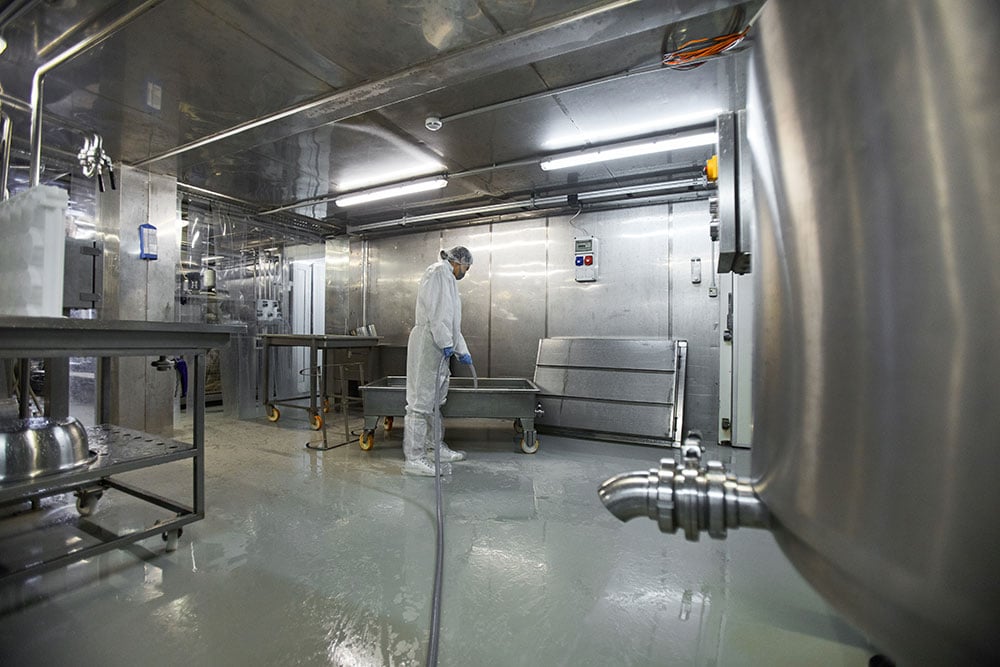Food safety is not something to take lightly. Food products can be unsafe and lead to foodborne illness without the proper precautions. Food safety laws outline what goes into food safety, by providing requirements and recommendations for food manufacturers and retailers. One requirement outlined in these laws is a food safety management system.
What is a Food Safety Management System?
According to the food safety management system definition, a food safety management system (FSMS) is a program meant to help ensure the safety and quality of food products. It is a requirement for most companies that deal with food, but also certain regulations and laws, including ISO 22000, the BRCGS Global Standard, and the U.K. Food Safety Act of 1990.
Systems can vary depending on the potential food hazards in a given food business. Despite any differences, all systems consider every step of the production process, from receiving supplies and ingredients to distribution.
Food manufacturers must legally implement and maintain a food safety system, with proper documentation of all food safety procedures, to prove an established line of defense is in place. The system must be based on the principles of Hazard Analysis Critical Control Point (HACCP).
What is the Purpose of a Food Safety Management System?
The purpose of a food safety management system is to ensure the safety and quality of food products as they move through the production and supply chain. It acts as a guide for food handlers on how to handle food safety procedures properly and maintain the appropriate levels of food hygiene to protect consumers from potential foodborne illnesses.
Other purposes of a food safety system are to help manage kitchen safety and maintain valuable business partnerships and consumer confidence.
Elements of Food Safety Management Systems
Food safety management principles combine many different elements, including the following:
Prerequisite Programs (PRPs)
PRPs consist of various plans to establish safe and sanitary conditions for food businesses. These programs include basic food handling practices, like food hygiene and minimum food operations. Some examples of PRPs include:
- Good Manufacturing Practices (GMP)
- Good Agricultural Practices (GAP)
- Good Hygienic Practices (GHP)
HACCP
HACCP is an international method of ensuring food is safe to eat. It involves identifying potential food hazards or Critical Control Points (CCP) and finding ways to eliminate or control them. Each CCP must include a critical limit or minimum and maximum value. Other HACCP principles include:
- Monitoring procedures
- Corrective actions
- Verification procedures
- Documentation procedures
Hazard Analysis and Risk-based Preventive Controls (HARPC)
The Food Safety Modernization Act of 2011 (FSMA) required food production facilities in the U.S. to establish a risk-based preventive control program in place of HACCP programs, called Hazard Analysis and Risk-based Preventive Controls Systems, or HARPC. The systems are proactive approaches to food safety that aim to address food safety hazards before they occur.
International Organization for Standardization (ISO)
Te ISO is a non-governmental organization that helps establish food quality and safety standards and management systems for the food industry. It has established numerous different requirements and standards, including ISO 22000.
ISO 22000 outlines the most critical food safety standards a food business must have. The standard incorporates other versions of standards and elements of a HACCP system.
The Importance of Drainage in a Food Management System

A food management system encompasses many different elements regarding food safety. Many of these elements address similar things, like the need for sanitary drainage in food processing facilities.
At FoodSafe Drains, we pride ourselves on offering safe, effective drainage solutions for the food industry. All of our products are NSF/ANSI/3-A certified, with T304 and T316 stainless steel used in their construction. The drains also are forklift rated, to ensure that they can handle traffic and heavy machinery without bending, breaking, or bowing.
The FoodSafe 10,000 Series Slot Drain is one option, with three channel widths that don't require grate covers. Despite their small size, they can handle flow rates up to 27 GPM. For larger flow rates, there is the FoodSafe Trench Drain. A 1-inch thick, hygienically designed forklift-rated grate protects this more traditional system. Both systems are compatible with clean-in-place technology for easy and automated cleaning and sanitation.
We also offer a hygienic Floor Sink and various styles of hub and area drains suitable for various areas within food processing facilities. These feature similar designs to the FoodSafe Trench Drain because a heavy-duty grate protects them. The FoodSafe Floor Sink is also equipped with the company's Tamper-Proof Magnetic Strainer that is only accessible by authorized personnel who have a key.
The Tamper-Proof Magnetic Strainer is also found in our Catch Basin. It is compatible with the Slot and Trench Drain systems and helps catch large debris before it can enter the channel, to minimize the risk of clogging.
Creating a Food Safety System
Understanding the purposes of food safety management system planning and implementation is critical. Food safety plans help facilities ensure their operations are safe and sanitary and operate within the various food safety laws and regulations. Beyond that, food safety management systems can help ensure you maintain your customers' confidence and trust.
These systems are relatively easy to set up, but you want to take the time to do it right and address every important detail–like the need for sanitary drainage.
Contact FoodSafe Drains today to learn more about the systems we offer and how we can fit in a food safety management system!


